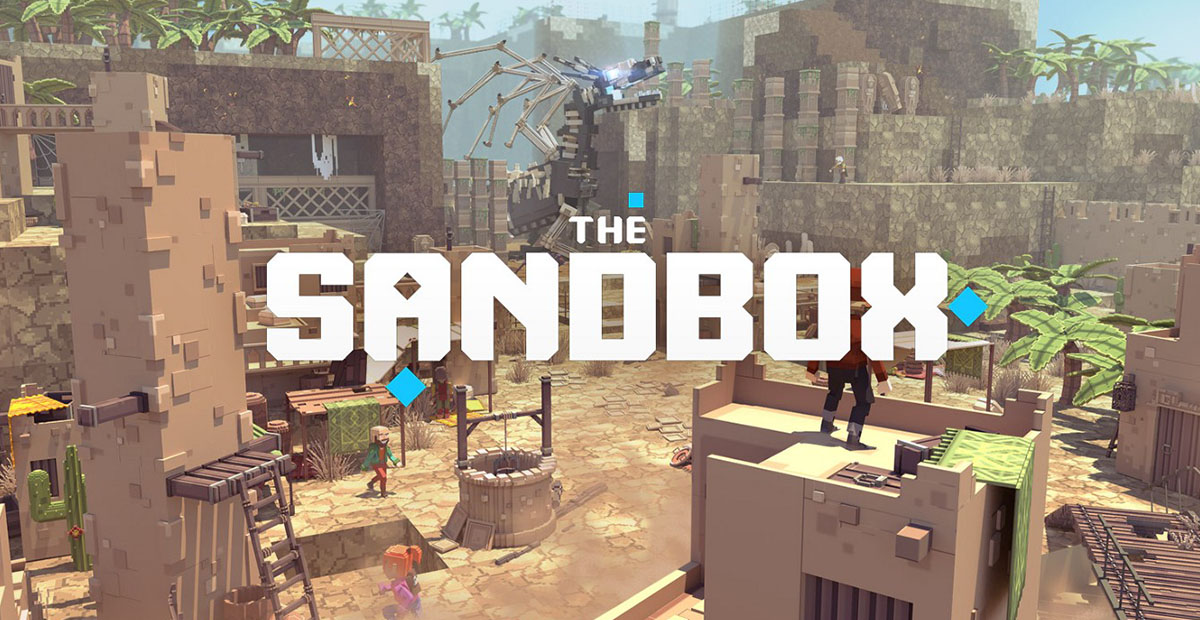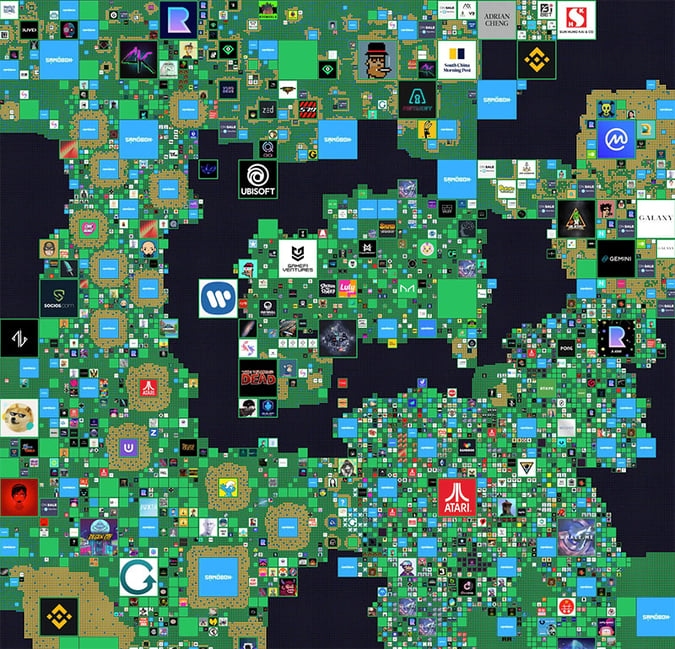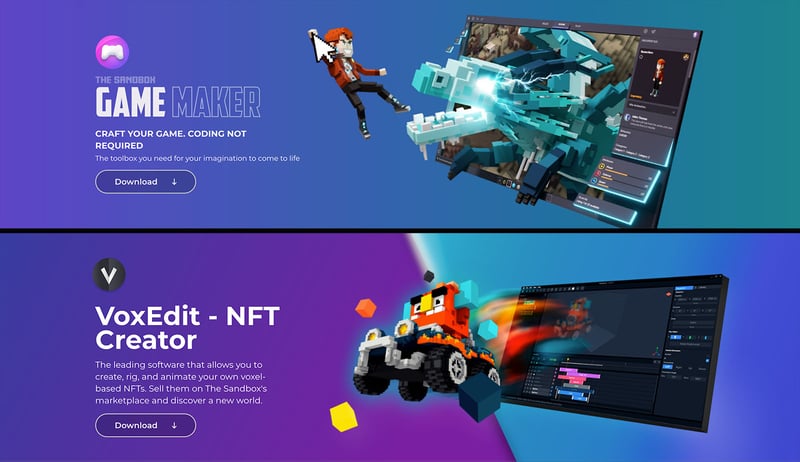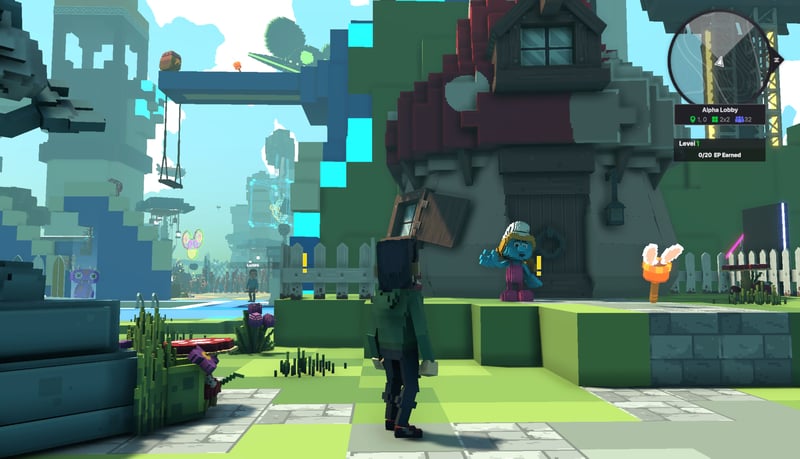
Meta-virtual worlds: An overview of The Sandbox
Written by Brett Rakestraw
Any definition of the eventual metaverse includes the emergence of 3D modeled virtual world platforms to explore. While plenty of virtual worlds already exist in the gaming community, there are a smaller set of new players using the blockchain to add digital ownership rights and more interoperable features that will help bring the metaverse into reality.
We recently wrote about Decentraland, one of the first virtual world platforms on the blockchain. Today, we’ll cover The Sandbox, a newer entry into the market with significant hype and high hopes for success.
While Decentraland was conceived in 2017 with the initial rise of cryptocurrencies and blockchains, The Sandbox has a slightly different history.
The Sandbox was initially created in 2012 as a mobile game, and claims over 40 million downloads of the original application. But in 2018, right around the time of Decentraland’s launch, development began on a blockchain version of the Sandbox ecosystem.
In early 2020 public “LAND” sales began in waves with each parcel represented by an NFT. At the time of writing, The Sandbox has sold roughly 67% of the 166,464 total LAND parcels on the primary market, opening up new sections for sale each quarter.

The Sandbox map overview
While land parcels in Decentraland are scaled around the size of a typical residential land parcel, about 65ft x 65ft, the land parcels in The Sandbox are roughly 5x larger at about 315ft x 315ft. This is more conducive to a game play environment where a user can run around and explore while staying within the property borders.
Individual land parcels within The Sandbox come at two price points, with most land being considered standard and a smaller number of parcels categorized at premium based on their proximity to high-profile attractions like branded experiences. These prices are calculated in SAND tokens. For example, a standard parcel is always 1,011 SAND, regardless of the price of SAND on the open market.
When originally released in 2020, SAND traded for about $.07. In the height of the 2021 hype cycle, SAND prices rose to an all time high of $8.40. SAND currently trades just under a dollar. So, buying a new Sandbox land parcel today would cost about $1,000 on the primary market.
The Owner Experience
Just like with land in Decentraland, owners of land parcels have control over what they do with the land, including the development of games or experiences, as well as the ability to sell or rent the land as they see fit. The limitations as to what an owner can create fall under common guidelines as anything that isn’t NSFW, hateful, or libelous.
Unlike Decentraland, The Sandbox is owned and operated by a private company and may choose to make some changes without seeking consent from the land owners themselves. However, the ecosystem SAND token is governed by a DAO that gives token holders voting rights. The Sandbox has stated that they intend to be fully decentralized within the next 5 years.
At this point, land owners can develop their own experiences using The Sandbox Game Maker application, which doesn't require coding skills to use, and they can develop custom assets and wearables using The Sandbox VoxEdit tool. However, The Sandbox is not yet available to the public on a wide scale, so owners can’t monetize their creations or share them with potential fans just yet.

The Sandbox creator tools
The platform is inching its way to a wide scale public release, but no official dates have been set. For now, land owners have to be content with experimentation until they are allowed to share their mini-worlds with the wider public.
The User Experience
For the most part, the user experience within The Sandbox has been limited to viewing the 2D land map and exploring the digital asset marketplace. However, The Sandbox launched a series of “Alpha Seasons” with a curated set of experiences for the public to test. The latest, Alpha Season 3, includes over 90 experiences with prizes for participants and an increasingly clear view of what The Sandbox has to offer.
According to Messari, The Sandbox Alpha Season 1 had 128,622 participants, while Alpha Season 2 snagged 292,069 participants. These numbers are nowhere close to the hundreds of millions of users on gaming giants like Roblox and Fortnite, but they are promising compared to the thousands of users that Decentraland currently sees daily.
The world of The Sandbox is built with voxels, meaning that it shares a similar style to other popular virtual worlds like Minecraft and Roblox. This gives The Sandbox a familiar feel for anyone coming from those platforms, and the intentional use of low-polygon cubes shields them from common criticisms over levels of realism in emerging metaverse platforms.
We can’t give a full review of the user experience in The Sandbox without wider access to the entire platform, but the Alpha Season experiences, while limited in immersive gameplay, do have a more polished appearance than many of the competing virtual worlds. Most experiences seem to run smoothly, and the environments are inviting for exploration.
The Brand Experience
As mentioned previously, The Sandbox is not yet a public platform, so brands don’t have a lot of options for activations today. However, the team at The Sandbox must have a great presentation deck, because brands have been lining up to join the platform.
Brand partnerships have been a big part of the Sandbox ecosystem from the beginning, with early partnerships announced for legacy IP brands like The Smurfs, The Care Bears, and Atari. As the platform has gained more attention and hype, the partnerships have increased. Mega-celebrities like Snoop-Dogg, Paris Hilton, and Gordon Ramsey all have partnered with The Sandbox to create avatars and digital assets as well as promises of future experiences on the platform.
With the current Alpha Season 3 release, 27 of the 99 included experiences are brand activations, including experiences from Warner Music, The Walking Dead, Deadmau5, and Ubisoft’s Rabbids, as well as experiences from web3 native brands like World of Women and Bored Ape Yacht Club.

The Sandbox brand experience
While it’s clear that The Sandbox is taking a similar approach to Roblox in many ways, from its simplified graphics look to its push for branded experiences, they will have a long road ahead to achieve the numbers that Roblox currently promotes, including “millions of visits to branded experiences in 2021.”
The Future Experience
While The Sandbox has not yet launched publicly, their proposed roadmap includes references to a mobile release in Q4 of 2022 and expectations of 5,000 gaming experiences in 2023. While 5,000 experiences would be an achievement for the startup metaverse brand, it’s worth noting that Roblox boasts over 40 million experiences on its platform.
The timing for The Sandbox release is also tricky as NFT prices have plunged in recent months and metaverse skepticism is on the rise. But, amongst the current slate of blockchain enabled virtual world platforms, The Sandbox has positioned itself well, with $95M in venture funding, a wide range of celebrity and brand partnerships, and perhaps most importantly, an upcoming mobile release. While the metaverse is often defined as something to be experienced in a fully immersive VR environment, today mobile phones still command most of our attention. And, it will likely be much easier to meet the audience where they are today than to try and drag them into a new world that hasn’t even been fully defined.
Key Takeaways
Lean into brands
Just like Decentraland, The Sandbox is leaning into brand partnerships to drive hype and adoption for the nascent platform. This serves to also benefit brands who are looking to make their first move into the metaverse.
Bigger might be better
The jury is still out as to whether metaverse land scarcity is a good thing, but while The Sandbox has a limited number of plots, the larger plot scale means more opportunities to create stickiness with users who visit an experience.
Follow the leaders
Rather than attempting to reinvent the wheel for virtual worlds, The Sandbox has looked to the most successful platforms for inspiration and insight. Their attempt to bridge the worlds of web 2.0 and web3 with familiar experiences that add new utility, may be the ticket to success.
Meet your audience where they are
We have a long way to go before we are all strapped into immersive headsets for 10 hours a day (if we even want that). In the meantime, the push to launch on mobile gives The Sandbox an opportunity for quick growth on devices that are already ubiquitous in our daily lives.
Topics: brand promotions, creative strategy, future of creativity, brands
